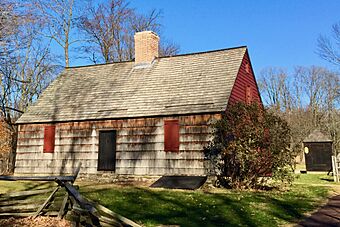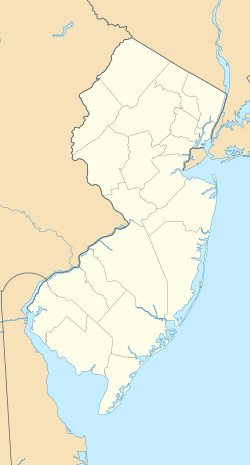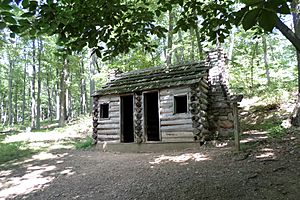Jockey Hollow facts for kids
|
Jockey Hollow
|
|
|
U.S. Historic district
Contributing property |
|

Wick House at Jockey Hollow in 2016
|
|
| Area | 1,307.49 acres (5.2912 km2) |
|---|---|
| Part of | Morristown National Historical Park (ID66000053) |
Quick facts for kids Significant dates |
|
| Designated CP | October 15, 2000 |
Jockey Hollow is a special place in Morris County, New Jersey. In the 1700s, families like the Wicks, Guerins, and Kembles farmed this land.
During the American Revolution, Jockey Hollow became a very important winter camp for the Continental Army. This was the main army fighting for America's freedom. They stayed here during the "Hard Winter" of 1779–80, which was one of the coldest winters ever recorded!
Today, Jockey Hollow is part of Morristown National Historical Park. This park is managed by the National Park Service. It helps us remember the brave soldiers and what they went through.
Contents
Jockey Hollow: A Winter Camp for Soldiers
During the Revolutionary War, Henry Wick owned a large farm here, about 1400 acres. This area was perfect for a winter camp. It was far enough from the British soldiers in New York City. There was also plenty of timber for building shelters and for firewood. Plus, there were houses for important officers, like generals, to stay in.
In the winter of 1779–1780, soldiers cut down a lot of trees. They used about 600 acres of Wick's timber. In total, they cut down about 2000 acres of trees in Jockey Hollow. This wood was used to build huts and keep warm.
The Historic Wick House
The Wick family lived in a house that is still standing today. In 1777, they hosted Captain Joseph Bloomfield.
During the tough winter of 1779–1780, the Wicks opened their home to General Arthur St. Clair. He was a commander of the Pennsylvania Line, a group of soldiers. Several of his helpers also stayed there.
Today, the Wick House has been carefully restored. You can visit it at Morristown National Historical Park. It helps visitors imagine what life was like during the Revolution.
The Wick Kitchen Garden
Next to the Wick House, there is a kitchen garden. It's cared for by the Northern New Jersey unit of the Herb Society of America. This garden shows the kinds of plants and herbs that families like the Wicks would have grown for food and medicine.
The Toughest Winter: 1779-1780
In December 1779, more than 10,000 Continental Army troops arrived at Jockey Hollow. They camped here until June 1780. During this time, they faced some of the hardest conditions of the entire war.
Jockey Hollow was a safe place to camp. The dirt roads were bad in winter, making it hard for enemies to travel. The area was far from the British in New York. Also, the Watchung Mountains acted like natural walls, protecting the army.
This winter was even worse than the famous winter at Valley Forge two years before. Soldiers lived in simple huts, with twelve men often sharing one hut. Even with little food and freezing temperatures, fewer than 100 soldiers died. Only about one out of ten soldiers left without permission. This shows how determined they were!
How Soldiers Lived: Huts and Homes
Soldiers had to build their own huts. These huts were made of logs and were about 14 by 16 feet (4.3 by 4.9 m) wide and 6.5 feet (2.0 m) tall. They also dug trenches around the huts to help with drainage.
Inside, the huts had a fireplace for warmth and cooking. The floor was just packed earth. Soldiers also made their own furniture, like bunks and tables. Their bunks were covered with straw. Each soldier was supposed to get one blanket, but many didn't have one.
The huts were built close together, about 2 to 3 feet apart. Each regiment had three rows of eight huts. By 1780, the soldiers had built around 1,200 huts in Jockey Hollow.
Today, you can see four replica huts on Sugar Loaf hill. They were built in 1964. There is also a marker from 1932 for the "Jockey Hollow Hospital" nearby.
A Soldier's Protest: The Pennsylvania Mutiny
On December 21, 1780, Henry Wick passed away at Jockey Hollow. A few weeks later, in January 1781, a group of soldiers from the Pennsylvania Line had a serious disagreement. They were camped in Jockey Hollow under General Anthony Wayne.
Many soldiers believed their time in the army was over when the new year began. However, the army said their enlistment was "two years or during the war," meaning until the war ended. The soldiers decided to march to Princeton, New Jersey, to talk to their leaders.
The protest ended peacefully. Leaders from Pennsylvania met with the soldiers. Some soldiers agreed to stay in the army. This event is thought to be the largest soldier protest during the American Revolutionary War.
A famous book about this event is "Mutiny in January," written by Carl Van Doren in 1943.
What You Can See Today
- Jockey Hollow Visitor Center: This is a great place to start your visit and learn more.
- Wick House: You might see park employees dressed in old-fashioned clothes, showing what life was like back then.
Fun Things to Do at Jockey Hollow
- Biking: You can ride your bike on the roads.
- Bird Watching: Look for different kinds of birds in the park.
- Hiking: Explore the trails and see the beautiful nature.
- Interpretive Programs: Join a program to learn more about the history.
- Snow Skiing: If there's snow, you can go cross-country skiing.
- Children's Junior Ranger Program: Kids can become Junior Rangers and earn a badge!
Learn More About the Revolution
- New Jersey Brigade Encampment Site - Another place where soldiers camped during the same winter.
- Temperance Wick
- William W. Wick
- Hilton Wick
- Valley Forge - Another famous winter camp for the Continental Army.
- Craig House
- Washington Rock State Park





